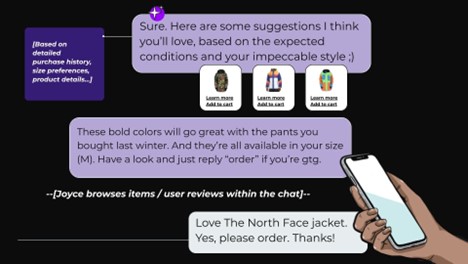Written by Joyce Gordon, Head of Generative AI, Amperity
In the customer experience landscape, the fervour surrounding generative AI has reached a crescendo. However, for many consumer brands, the divide between expectations and reality looms large. Brands envisioning a seamless, magical customer experience must recognise that AI’s effectiveness depends on high-quality underlying data. Without that, the AI falls flat, leaving brands grappling with a less-than-magical reality.
AI-powered customer experience with poor quality data
Let’s take a closer look at what AI-powered customer experience with poor data quality could look like. Say I’m a customer of a general sports apparel and outdoor store, and I’m planning for my upcoming annual winter ski trip. I’m excited to use the personal shopper AI to give me an experience that’s easy and customised to me.
I need to fill in some gaps in my ski wardrobe, so I ask the personal shopper AI to suggest some items to purchase. But the AI is creating its responses based on data about me that’s been scattered across the brand’s multiple systems. Without a clear picture of who I am, it asks me for some basic information that it should already know. Slightly annoying… I’m used to entering my info when I shop online, but I was hoping the AI upgrade to the experience would make things easier for me.

Because my data is so disconnected, the AI concierge only has an order associated with my name from two years ago, which was actually a gift. Without a full picture of me, this personal shopper AI is unable to generate accurate insights and ends up sharing recommendations that aren’t helpful.

Ultimately this subpar experience makes me less excited about purchasing from this brand, and I decide to go elsewhere.
The culprit behind a disconnected and impersonal generative AI experience is data quality — poor data quality = poor customer experience.
AI-powered customer experience with high quality data
Now, let’s revisit this outdoor sports retailer scenario, but imagine that the personal shopper AI is powered by accurate, unified data that has a complete history of my interactions with the brand from first purchase to last return.
I enter my first question, and I get a super-personalised and friendly response, already starting to create the experience of a one-on-one connection with a helpful sales associate. It automatically references my shopping history and connects my past purchases to my current shopping needs.

Based on my prompts and responses, the concierge provides a tailored set of recommendations to fill in my ski wardrobe along with direct links to purchase. The AI is then able to generate sophisticated insights about me as a customer and even make predictions about the types of products I might want to buy based on my past purchases, driving up the likelihood of me purchasing and potentially even expanding my basket to buy additional items.

Within the experience, I am able to actually use the concierge to order without having to navigate elsewhere. I also know my returns or any future purchases will be incorporated into my profile.
Because it knew my history and preferences, Generative AI was able to create a buying experience for me that was super personalised and convenient. This is a brand I will keep returning to for future purchases.
In other words, when it comes to AI for marketing, better data = better results.
So how do you actually address the data quality challenge? And what could that look like in this new world of AI?
Solving the data quality problem
The critical first element to powering an effective AI strategy is a unified customer data foundation. The tricky part is that accurately unifying customer data is hard due to its scale and complexity — most consumers have at least two email addresses, have moved over eleven times in their lifetimes and use an average of five channels (or if they are millennials or Gen Z, it’s actually twelve channels).
Many familiar approaches to unifying customer data are rules-based and use deterministic/fuzzy matching, but these methods are rigid and break down when data doesn’t match perfectly. This, in turn, creates an inaccurate customer profile that can actually miss a huge portion of a customer’s lifetime history with the brand and not account for recent purchases or changes of contact information.
A better way to build a unified data foundation actually involves using AI models (a different flavour of AI than generative AI for marketing) to find the connections between data points to tell if they belong to the same person with the same nuance and flexibility of a human but at massive scale.
When your customer data tools can use AI to unify every touchpoint in the customer journey from first interaction to last purchase and beyond (loyalty, email, website data, etc…), the result is a comprehensive customer profile that tells you who your customers are and how they interact with your brand.
About the author

Joyce Gordon, Head of Generative AI, Amperity
Joyce is the Head of Generative AI at Amperity, leading product development and strategy. Previously, Joyce led product development for many of Amperity’s ML and ML Ops investments, including launching Amperity’s predictive models and infrastructure. Joyce joined the company in 2019 following Amperity’s acquisition of Custora where she was a founding member of the product team. She earned a B.A. in Biological Mathematics from the University of Pennsylvania and is an inventor on several pending ML patents.
About Amperity
Amperity delivers the data confidence brands need to unlock growth by truly knowing their customers. With Amperity, brands can build a unified customer profile foundation powered by first-party data to fuel customer acquisition and retention, personalize experiences that build loyalty, and manage privacy compliance. Using patented AI and machine learning methods, Amperity stitches together all customer interactions to build a unified view that seamlessly connects to marketing and technology tools. More than 400 brands worldwide rely on Amperity to turn data into business value, including Alaska Airlines, Brooks Running, Endeavour Drinks, Planet Fitness, Seattle Sounders FC, Under Armour and Wyndham Hotels & Resorts. For more information, please visit www.amperity.com or follow us on LinkedIn, Twitter, Facebook and Instagram.


